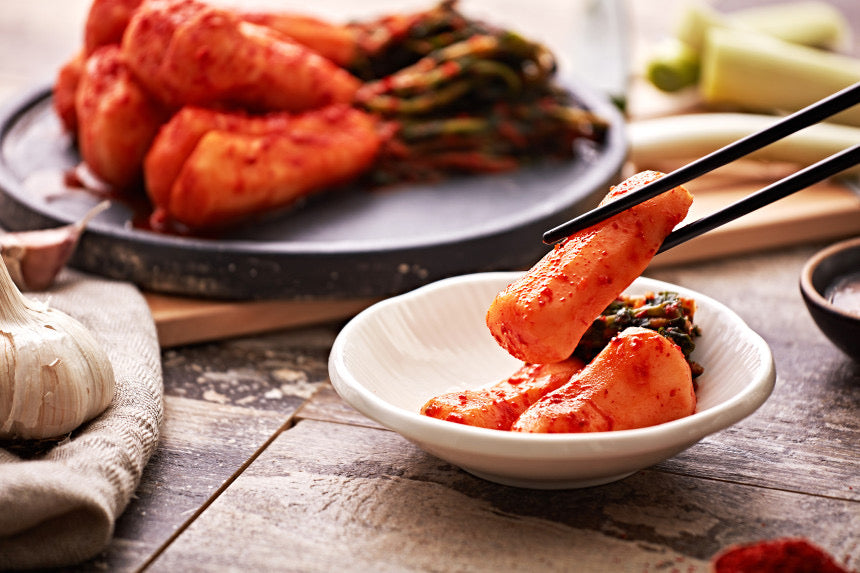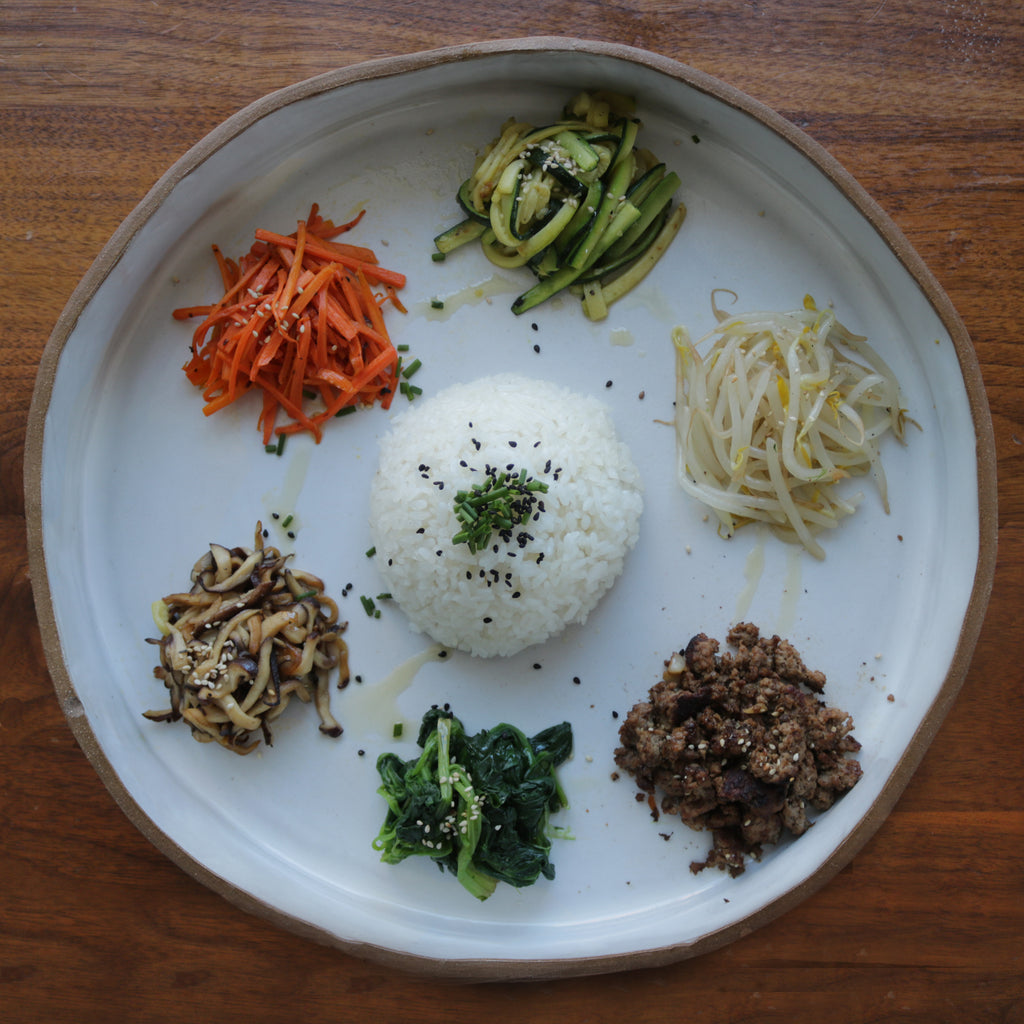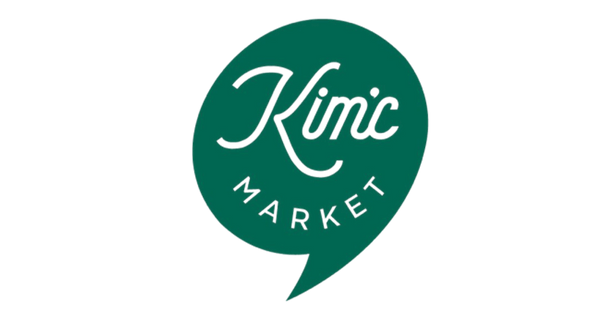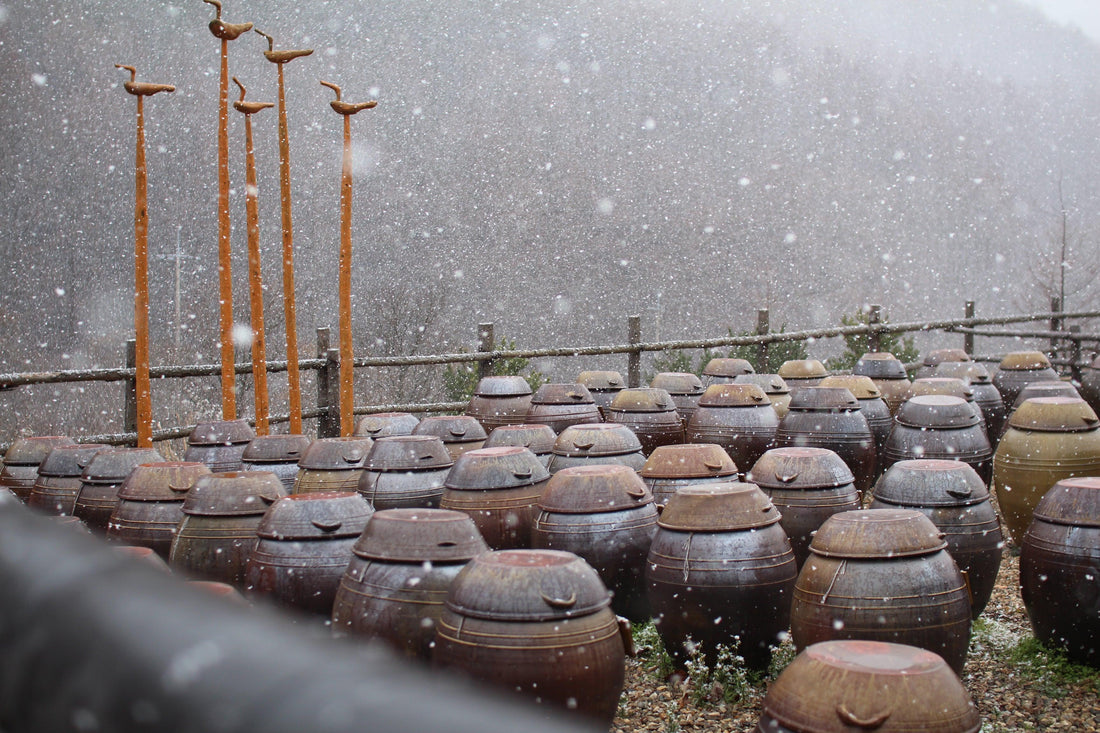With trends coming and going faster than ever, the seemingly endless popularity of fermentation and probiotics in the cultural consciousness is nothing short of impressive. There’s definitely a reason, however, that these topics feature so prominently in foodie circles, on wellness blogs, and on food packaging. Probiotics are an important part of overall gut health, and recent studies suggest that they have the ability to improve your mental state as well.
While humans have not always understood why products of fermentation with probiotics were beneficial to our bodies, these foods have been prominent in many cultures across the globe throughout history, spanning back as far as the Neolithic Era. Clearly, humans have always understood that fermented foods have a positive impact on our overall well-being, and have harnessed them for that purpose, or for the simple fact that they taste so good.
What is Fermentation?

Jookjangyeon Gochujang
So, what is fermentation at its core? It is a natural process that occurs in our cells which converts carbohydrates into energy. All cells of higher organisms are capable of this process. Chemically, fermentation begins with glucose molecules and converts them into lactic acid, carbon dioxide, and energy, which is called ATP in the field of chemistry. It is one of the oldest metabolic pathways, which are a series of chemical reactions that all happen in a singular cell. Fermentation has been around for so long because it is an anaerobic process, meaning it occurs only in the absence of oxygen. So, simply put, it could take place before plant life existed on earth.
Our muscle cells use fermentation during intense exercise. When we exercise, our muscles do not get as much oxygen as they normally do. Without the presence of oxygen, fermentation is able to take place. Then, we produce lactic acid, also called lactate, that then builds up in our muscles. This is called lactic acid fermentation, which is a byproduct of anaerobic respiration within our cells.
Digestion is also a fermentative process. When we digest food, it breaks down into nutrients that can be used by our bodies because of fermentative bacteria that lives in our gut. We obtain energy from the breakdown of carbohydrates, such as lactose and other sugars, and the breakdown of glucose molecules through glycolysis. Clearly, fermentation is a vital part of keeping our bodies functioning properly.
In relation to food production, fermentation adds microorganisms, typically yeast or desirable bacteria, to a liquid or food, and oxygen is removed, leaving an environment in which good bacteria can thrive. Since a chemical result of this process is organic acids, such as acetic acid, pyruvic acid, citric acid, or lactic acid, fermented foods have a naturally low pH. The acidity of the item naturally discourages the growth of bad bacteria. A pH level of 4.6 is desirable to ensure safety through the elimination of microbial bacteria, but many commercial products are expected to reach a level of 4.2 to prevent illness among their customers and provide a safe product to the public.
Since bacteria are central to the process of fermentation, food safety is a concern when picking out fermented goods to incorporate into a well-rounded diet. Undesirable bacteria should not be able to flourish under anaerobic conditions, however, it is key to use safe practices when preparing fermented foods. Proper sterilization of canning supplies when home canning is instrumental to avoiding spoilage and illnesses such as botulism. Additionally, if you are making fermented goods at home, it is a good rule of thumb to check on them every day to ensure they are not spoiling. Fermentation is a form of decomposition, but it is also a method of food preservation. Use intuition and personal taste to decide if a fermented food is safe to be eaten.
History of Fermentation

Haedamchon Radish Kimchi
Fermentation was likely discovered by accident. It has been suggested by various historians that a single microbe (either a bacterium or some yeast) might have made its way, spontaneously, into a pot of milk or other fermentable food, and simply created a new end product. These early discoveries were not documented, so it is difficult to determine the exact origin of some of our favorite dishes.
However, archaeologists have discovered various fermented foods present at dig sites, and have traced the earliest evidence of humans consciously practicing fermentation in a cave near Haifa, Israel. The discovery of this 13,000 year old beer confirmed that fermentation has held as significant of a role in our distant ancestors’ daily lives as it does in our contemporary lives.
Many of the other discoveries of early fermentation also involved alcohol, which is brewed with yeast rather than bacteria. The yeast produces ethanol as it ages and interacts with the sugars in the drink. It infuses the grape juice, beer, or other beverages with alcohol through ethanol fermentation, also known as alcoholic fermentation.
One specific type of yeast, saccharomyces cerevisiae, has been in use to produce fermented alcohol since ancient times. Archaeological evidence proves that people in ancient China were harnessing the power of this process to produce fermented beverages with rice, honey, and fruit as early as 7000 BCE. Throughout the middle ages, Europeans created a strong brewing culture among monastic communities, who often would share their beer with locals, fermenting different batches and experimenting with recipes in their monasteries.
Alcoholic beverages do not retain a significant enough amount of probiotics to be exceptionally beneficial to our health, but they do play a part in the history of fermentation. Another probiotic drink that has become increasingly popular throughout the past decade is kombucha, which does retain a good amount of its beneficial bacteria after being bottled.
It was not until the 19th century that the cause of fermentation was identified by Charles Cagniard de la Tour, Theodor Schwann, and Friedrich Traugott Kützing as a living organism, namely, yeast. This epiphany allowed for further discoveries, such as Louis Pasteur’s discovery of pasteurization.
During the Meiji era in Japan, scientists began to study a type of mold called koji. They collaborated with European scientists to delve deep into the creation of koji mold, which was often used to make other foods. Their studies led to the establishment of the field of microbiology, which Japan pioneered along with scientists from around the world.
Fermented foods were discovered to have a positive effect on humans’ wellbeing in the early 20th century. Scientist Elie Metchnikoff studied the Bulgarian diet to figure out why they lived much longer on average than those in other cultures. He discovered a strain of bacteria present in cultured and fermented milks consumed in Bulgaria called Lactobacillus bulgaricus, and attributed the robust health of Bulgarians to this probiotic bacteria. After continued study, various other strains of probiotics were identified and shown to have beneficial effects on the body.
Types of Fermentation used in Food Production

Meshil, a fermented plum syrup
There are multiple ways to infuse foods with the deep taste and benefits of fermentation. The most common type is batch fermentation, in which all of the ingredients are combined into a single container and after time, the food or beverage simply ferments on its own without any further attention or ingredients. Another subtype of the batch method is called fed-batch fermentation. In this process, the batch method is used, but certain ingredients are added while the food ages to “feed” the batch.
In continuous fermentation, a substrate is added to the mixture and the end product is taken out regularly. This is more efficient than the batch or fed-batch methods because it does not require starting over once a batch is ready to consume. The mixture left behind when the final product is created is able to be reused over and over, which makes it easier in the long run.
Industrial fermentation is another option, although this method does not produce food, but instead uses chemical synthesis to create biofuels, chemicals, and sometimes even pharmaceuticals. This process requires a great deal of equipment and technical knowledge of microbiology and chemistry.
Modern Fermentation Trends

Thank-You Gochujang and Tteokbokki
More recently, probiotics have taken the world by storm in the wake of various wellness trends and a societal shift towards self-care. According to Upserve, fermented foods experienced a 149% increase on their customer menus in 2018, showing that this craze is not going away any time soon. Additionally, Forbes noted that the frenzy surrounding fermentation is mainly focused on trying new foods, not familiar ones. They stated that traditional staples, such as sauerkraut, are not spiking in popularity, but rather, items like kimchi, which is a newer item to many consumers in the United States.
Due to advancements in modern science and technology, scientists have been able to select specific strains of probiotics and even create hybrid strains of their own. These strains are able to address different ailments, and can be utilized as a medical treatment when prescribed or chosen by licensed healthcare professionals.
While you may not have realized it, you likely consume fermented foods each day, or at least a few times a week. Some obvious sources of probiotics are pickles, cheese, and yogurt, but there are many other ways to fit probiotic superfoods into your diet. Sauerkraut is one of the first dishes that comes to mind when discussing probiotics, and it is a great source of good gut bacteria. Kefir, a yogurt-like beverage enjoyed in eastern Europe, is filled with probiotics and good lactic acid bacteria, but only became commercially available in the early 20th century even though it has existed since before written history began. Because of their low concentration of living cultures, alcohol would not be a great substitute for daily probiotic pills, it is better to opt for something with a higher concentration of good bacteria, like yogurt. One food that we love for its probiotic qualities is kimchi. There’s such a wide variety of options to choose from, and it can be made fairly easily (and safely) at home!
Kimchi is not only a fermented dish, but also includes fermented ingredients like gochujang and shrimp paste. Shrimp paste was originally created from sun-dried shrimp to preserve it in the hot climates of southeast Asia, but now is simply a way to enjoy seafood and the beneficial aspects of probiotics. Many other Korean foods have probiotic qualities thanks to the inclusion of various jangs, or fermented sauces, and kimchi as featured ingredients.
Probiotics
Our gut microbiome consists of the living strains of probiotics that exist in our digestive system. Nurturing this microbiome is instrumental to keeping in good health because it supports our immune system in fending off illnesses. The bacteria in our body helps us to break down waste and absorb nutrients, especially complex carbohydrates. Research even suggests that they can protect us from various diseases such as cancer, IBS, and colitis. By nurturing one’s microbiome, we are able to remain in a state of equilibrium where the good bacteria in our gut protects us from the bad.
Probiotics facilitate this balance in our digestive system. By maintaining a balance of good and bad bacteria, we are able to fend off disease, better absorb vitamins and nutrients, and keep our immune system functioning and defending us from dangerous pathogens. If you do happen to get sick, the probiotics living in your gut still protect you. They can aid in the absorption of medicines, just as they help you extract nutrients from food.
Good bacterias found in fermented dishes are numerous, and they can combat tooth decay, improve digestion and body detoxification, and cure disease in a similar manner to antibiotics. In fact, as early as 500 BCE, communities in China used moldy soybean byproducts as an early antibiotic to treat disease. It has been proven that shrimp paste forms enzymes during the process of fermentation that can help our cardiovascular system function properly.
The benefits of probiotics are not limited to physical effects. Extensive research has been conducted in recent years concerning the effects of probiotic rich food and supplements on mental wellness. Our gut has a huge impact on our mind, and multiple studies support the fact that regularly consuming probiotics can support and improve one’s mental health. This means that eating fermented foods could actually make you a happier person.
How can I eat more fermented foods?

Haedamchon Green Onion Kimchi
So, how can we incorporate more fermented foods into our daily lives? One of the easiest suggestions is to eat simple, prepared foods that can be easily made or purchased, such as kimchi, sauerkraut, and kefir. Some foods can be made safely at home, like kombucha or kimchi, as long as you’re willing to wait for fermentation to take effect. Making your own kimchi and kombucha at home also gives a great amount of freedom in flavor experimentation. You can choose whichever base you’d like, whether that be green tea or black tea in kombucha or radish or napa cabbage in kimchi, to name a few examples.
Better with Age
One fun fact about (some) aged foods is that they taste better the longer they’ve been able to ferment. This is widely known about beer and wine, but for some items, like gochujang or doenjang, it is not universally understood. If items are kept properly sealed or refrigerated, they can age indefinitely, and the flavors will typically become more complex and interesting over time. With certain foods, such as cheese or even gochujang, which have formed mold or some sort of defect, you can simply scrape off the offensive portion and eat the good bits safely. Again, it is important to remember that fermented goods can go bad, so use both intuition and proper research to identify whether a food or beverage is past its prime.
Fermented Foods Available at Kim’C Market

Doenjang Jjigae
Kim’C Market offers a wide variety of fermented foods in our inventory. As a Korean grocery store, we offer many traditional probiotic sources such as our kimchi, which we ship fresh from Korea. We also offer a wide selection of jangs (장 or 醬), or Korean fermented sauces. Jookjangyeon produces premium gochujang, doenjang, and ganjang (soy sauce), among other delicious items. These can be added to so many different Korean dishes, including bulgogi, kimchi stew, doenjang stew, and tteokbokki, to name just a few. They can even be used to make fun fusion recipes like gochujang pasta, so get creative with it, and don’t limit yourself to solely traditional recipes.
Another great fermented item from Kim’C Market is our maesil, or plum extract. We carry golden plum maesil from Owl’s Storeroom and an organic maesil from Meshil. These delicious fermented syrups are a great (and convenient) source of good bacteria, and have traditionally been used to treat digestive issues. They are easy to use, and can be enjoyed as a refreshing summer beverage when simply added to sparkling water and ice. Alternatively, you can mix them into mocktails or cocktails of your choice to create a variety of delicious concoctions. Maesil makes a great addition to any salad dressing, adding a subtle, natural sweetness to your meal.
A more health-conscious alternative to sipping on maesil tea is our fermented bellflower and pear extract. This syrup can be eaten by the spoonful or mixed into hot or cold water to make a diluted drink with a milder flavor. We also offer the same extract in single-serve sticks. These convenient sticks are pre-portioned, allowing you to grab them on-the-go for immune support.
For those who are looking for a larger dose of probiotics, we have prepared foods that are ready to be cooked, such as our doenjang jjigae kit from Mrs. Malaenge or a prepared doenjang jjigae from DN Food, our octopus kimchi porridge, or our kimchi jjigae. We also have prepared foods that are completely ready to eat, such as our wide array of pickled seafood. We carry pickled wild caught shrimp, pickled cockle, pickled octopus, pickled abalone, pickled squid, and pickled sea squirts. Due to the pickling process, these items will all contain an abundance of good gut bacteria, allowing your microbiome to flourish.
Recipe Ideas

Bibimbap with Bulgogi
Our favorite way to add small amounts of probiotics into meals is by using our gochujang to make a homemade bulgogi marinade. For those that are okay with a bit of spice, you can add double the gochujang and get even more perks from these good bacteria. You can make a simple bulgogi marinade with our gochujang, fermented soy sauce, sesame oil, and gochugaru chili powder to taste. Grated pear can be added for some natural sweetness, but an even more convenient option would be a small amount of our probiotic maesil, grain syrup, or wild berries syrup. Be sure to garnish with sesame seeds or green onions, which you can also find at Kim’C Market. This meal can easily be transformed into a powerhouse of fermented ingredients, which we love for their ability to improve overall health.
A perfect option for your next banchan spread is spicy bok choy, which makes a great and refreshing addition to summer meals. This dish includes fermented Jeju fish sauce, which has a deliciously mild flavor due to the aging process. It also includes fermented soy sauce, or ganjang, and Jeju tangerine vinegar to pack in those probiotics.
One delicious Korean fusion recipe you can make is gochujang pasta. To make this dish, combine minced garlic with gochujang, tomato paste, red pepper flakes, parmesan, and a bit of cream in a pan and stir until combined. If you’d like a spicier dish, use our gochugaru chili powder instead of red pepper flakes. Let the sauce simmer on low for a few minutes, and then stir it into cooked pasta. This meal is very easy to make and packs a ton of flavor into each bite.
Harness Fermentation for Your Own Benefit!
Adding fermented foods into your diet is easy, and a great way to improve one’s overall wellness. With such a rich history, it’s clear that humans have always understood the value of fermentation and the resulting probiotics long before bacteria was discovered. It’s likely that you already consume some foods containing these good bacteria on a regular basis— who can resist cheese? However, consciously incorporating more foods that nurture the gut into your diet is a great choice for longevity and immunity. With Kim’C Market’s extensive catalog of fermented foods and ingredients, you can easily craft mouthwatering dishes that your friends and family will love, or to keep all to yourself! Eating and creating fermented foods allows us to connect to a cultural tradition from virtually all cultures around the world. In this way, they help us to go back to our roots and connect with our ancestors through food.
Keywords: South Korea, Korean food, Korean recipes, fermented foods, ferment, gochujang, doenjang, soy sauce


